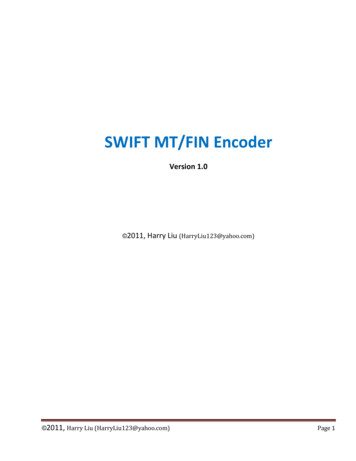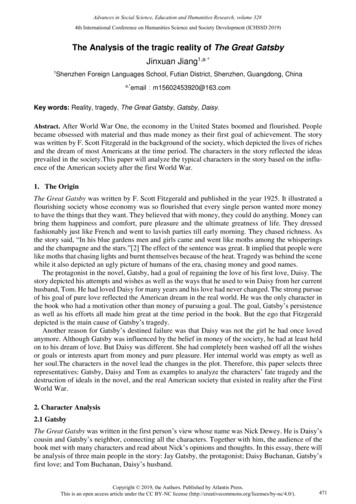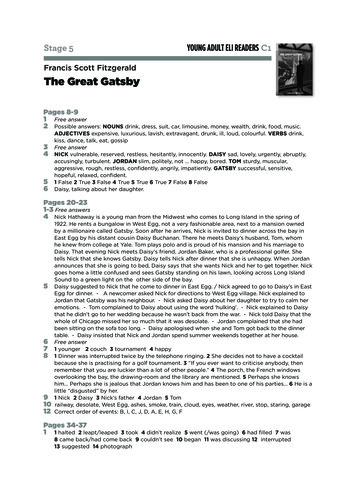
Transcription
The Mechanical Operation and Repair ofGatsby, Blue Ridge, and Swift RiverSpas built by Jacuzzi ONLY for the Following ELECTRONIC Spas Made 1999-2002 with this Topside:(does not Apply to ANY Model using other topsides)Published by GatsbySpaParts.com Copyrighted. All Rights Reserved. B.Bouman and Company, LLC20101
DisclaimerEvery effort has been made to make this manual understandable and applicable.If you have doubts or little experience with electrical appliances, it’s best to leaveelectrical work to licensed electricians. Care and proper electrical proceduresmust be adhered to whenever working with electricity and especially is true withspas since you are dealing with electrical current that can harm or kill you orthose near or in the spa.As a Rule of Thumb: ALWAYS TURN THE SPA’S MAIN POWER OFFUNLESS REQUIRED TO PERFORM A TEST. WHEN YOU DO HAVE POWERON BE CAREFUL AND USE PROPER ELECTRICAL PROTECTION ANDPROCEDURES.Although this booklet should be able to guide you through most repairs and evendiagnosing the problem, www.gatsbyspaparts.com offers an “Ask the Expert” freeof charge where you can write me and be more specific for your spa and yourparticular problem.Every effort has been made to be accurate and complete but note we cannotguarantee specific accuracy.Throughout this manual reference to part numbers are Jacuzzi/Gatsby Spanumbers, . If the part number prefix is “CC” the part is our own number andavailable on our website. Also note, normally, numbers on the part are notJacuzzi stocking numbers but numbers used by the original manufacturerincluding mold number. We have no cross reference from these numbers.2
Table of ContentsWords and Their Meaning.IntroductionOverviewSection One: Equipment and PartsChapter One:Pumps and MotorsChapter Two:HeatersChapter Three:Control SystemChapter Four:Air BlowersChapter Five:Pressure Switch: Flow SwitchChapter Six:SensorsChapter Seven:Topside ControlChapter Eight:OzonatorsChapter Nine:Mood LightsChapter Ten:PlumbingChapter Eleven:Spa JetsSection Two: TroubleshootingI. Trips GFCIII. Doesn’t HeatIII. Motor Hums or Doesn’t WorkIV. Pump LeaksV. Error Codes Defined and FixVI. Models3
Words and Their Meaning.“Spa”; typically means same as hot tub. Often get confused with indoor jettedbath. But spas normally are outside, require heating, and are operationally 24/7.“Pump”; Generally only applies to “wetend” or part that moves the water.Attaches to “motor”.“Motor”; part that when electrical current is applied it will spin. Normal low speedis 1725 rpm and 3450 for high. Can be one or two speeds. Some single speedmotors are dual voltage. On dual voltage motors usually the motor comes wiredfor high or 240vac. But always confirm from diagram on motor’s label which youmotor is. Usually apply high voltage to a low voltage motor will permanently harmit. Usually applying low voltage to a high voltage motor will if corrected quickly,not permanently harm it.“Jet”; The part of the plumbing that secures the piping to the spa shell and injectswater/air into the spa.“Topside”; the control pad on the outside of the spa that you operate the spa fromincluding temperature change and jet action.“Control Box” or “Command Center”; the box underneath that includes the pcboard and cables. Basically the “brains” of the spa.“Power”; spas are designed for either 110-130vac or 220-240vac. There is acertain tolerance of voltage but normally the range should be the above. Outsidethe range can harm equipment include the control box and pump motors. Somespas come designed to operate on either 115v or 230v. It this case, the differenceis efficiency of the spas heater and when it can come on. When the spa isoperated on 115v, the heater uses about 1/3 of its ability to heat. Therefore 1-2heating per hour is normal. When the same heater has 230v applied to it, the spawill heat 5-6 degrees per hour. On most system, when the jet pump is on highand the spa is operating on 115v, the heater turns off. When the spa is operatedon 230v, the heater will remain on. To gain this feature usually requires anadjustment on the board.4
IntroductionI started servicing Jacuzzi Whirlpool Bath spas in 1995. I first started by workingfor a friend who was an Authorized Service Center for Jacuzzi Whirlpool Bath.Shortly after that I purchased the spa repair business from him and became theowner.From that date to 2001 we were the authorized Service Center for JacuzziWhirlpool Products in the Denver and Eastern Colorado area. During that timewe were rated in the top 10 service companies in the United States for customerservice. We were the only Service Company to receive that award every time itwas offered during those years. When Jacuzzi, Inc reorganized their company in2001, they moved their spa production to their Sundance plant. We continue toand are still servicing Jacuzzi Hot Tubs as a service center.It just happened that when I started working and servicing spas for JacuzziWhirlpool Bath was also the time the industry was switching to electroniccontrolled spas. Therefore I experienced the changes that have occurred duringthis time and continue to work in the field, I have experienced a wide spectrum ofproblems and their solution. I would like to say I have seen it all but that alwaysproves untrue.I have tried to make this manual simple but comprehensive; quite a challenge. Todo so I try first to explain what and how the part works. Then how to replace orrepair the part.This manual also includes common failures and error codes and their solution.In the Troubleshooting Section I have found 99% of the problems with a spa areroutine if you follow a systematic approach. Sometimes I make this approach tooobvious but for the sake of the weekend warrior, I made it so.If you have questions not specifically addressed in this manual, you can contactme at bbouman@clearcreekspas.com. It’s the first email I check, usually everybusiness day. I will be happy to help all I can.5
OverviewWho is Gatsby?Gatsby was a manufacturer of hot tubs in Plant City, Florida. For years they builtentry level spas sold throughout the SE states. They produced a number of spamodels under brand names like Gatsby, Blue Ridge, Swift River, and ImperialSpas. In most cases, one model design will come under one or more of thoselabels.Jacuzzi bought Gatsby spas and began moving their entry level production toFlorida and have Gatsby division build all their entry level spas. Soon after that,Jacuzzi closed down production at that plant and discontinued all lines built bythat division.When Jacuzzi bought Gatsby the support of earlier production spas had alreadybeen discontinued. Jacuzzi service companies received no technical informationor parts for servicing those earlier, non-electronic spas. Unfortunately for spaowners of earlier non electronic models parts and support are not available.Jacuzzi recommendation to those owners with problems with their older controlsystem is to replace their older non-electronic spas with newer electronicsystems. We carry both those systems and more economical fully electronicaftermarket retrokits for these spas. See our website under “Tutor” for moreinformation.Therefore if your spa has a topside with a DIAL temp control and plunger like on/off buttons, there is not support or supply for that system. Motors and heaters areavailable but not your circ ump.GENERAL; How Spa’s WorkBasically, spa operation is simple. The pump draws the water from the spa,usually through a filter, then through the pump and pushes it through the heaterand back into the spa. Now add more jets, more pumps, an air blower, andmaybe a stereo. That’s today’s popular spa.America’s lust for more jets has driven the need for more pumps to drive the jets.6
To help keep the spa clean with less chemicals, manufactures have added a 24hour circulation pump and Ozonator. For a few models you also have an airblower that blows air bubbles up from the seats of the spa.GATSBY Specific SPA DESIGN:Most electronic spas built by Gatsby division have the following configuration:a. Main electronic control box.b. Separate canister heater.c. Small 24hr circulation pumpd. One of two large jet pumps.e. Jet pumps can be one or two speed.Less common configuration is:a. Main electronic control box with heater attached.b. NO circulation pump.c. One or two large jet pump.d. #1 jet pump is two speed. Low speed also operates to heat and filter.SPA SHELLSpa shells are typically acrylic. A sheet of acrylic is heated and dropped into amold and vacuumed to form the shell. Then it’s flipped over and sprayed with afiberglass solution that gives it strength. Holes are drilled into the spa and jetsinstalled. Then the plumbing is finished and insulation is now sprayed. Finally theequipment is installed. The construction of the spa is mostly performed with thespa upside down. Finally the spa is flipped upright and final tests including watertesting is done.The spa frame was made a wide variety of ways over the years but basically itwas on either a wood bracing, solid plywood base, or fiberglass base. Often thespa shell has part of the frame molded into the actual spa shell or glued to it tocreate strength.PanelingThe paneling of spas has changed over the years. Initially redwood slates werethe common siding. In an attempt to economize the cost of panels, Gatsby builtpanels with various stained wood. Some of the late production was synthetic7
plastic panels or slats. These are becoming popular even though they can be ascostly as redwood or cedar. But they are able to withstand the elements with littlecare.Typically you should re-stain pine panels every year.Newer spas with synthetic siding require little upkeep other than cleaning. I haveseen spas where the heat of the sun causes the panels to bow and lose shape. Ifyou see this happening, you might consider reinforcing the back of the panel witha piece of wood or where you can and available, add a screw or two to centerareas that are bowing. You will need to locate a wood vertical post to screw thepanel against to create more support and avoid bowing.8
Chapter ONEPump & MotorsOverview:There can be confusion; What’s a pump? What’s a motor? Are they the same?The “pump” is considered by many to be the complete pump/motor and byothers only the end where the water passes through. The “wetend” is the morecommon word for the end that moves the water. For the industry, “pump” and“wetend” are the same. “Motor” is JUST the motor. “Pump/Motor Complete”would be both already assembled. In most cases, “complete” does not mean witha new cord.I. Circulation Pump (see more later)Most Gatsby built spas used either the less common 115v small circulation pumpor the more common 230v circulation pump. This pump runs 24/7. It avails thehomeowner with a system that keeps water clean by constant filtering.Most common is full replacement of failed circulation pumps, not replacinginternal parts.II. Jet PumpYour spa will have one or two jet pumps. The pump motor can either by 115v or230v. Also it can be one or two speed. Plus, to complicate, there are two pumpstyles and a variety of pump horsepower. So how do you tell what you have?First, your pump is either center or side discharge. 1.5hp pumps can be eithercenter or side. All others are side. Center discharge means the top discharge isin the middle of the pump. Side discharge means your output of the pump is onthe side. Most pumps are side discharge but check.Next is pump’s horsepower. As a rule of thumb, the horsepower rating must beequal or less than the motor’s rating. If the pump is oversized for the motor, it9
likely will shorten the life of the motor or cause it to continue to overheat and shutoff. You can oversize the motor but not the pump.Jet pumps on Gatsby spas are basically a generic designed pump. The mainbody or bracket mounts on the motor by the 4 bolts that hold the motor togetherand pump to motor.Next part of the pump is the mechanical seal. This seal is 2 pieces. One piecegoes into the seat cup of the pump housing. The other slides on the impellor’sshaft. When the impellor tightens to the motor shaft, the two halves pressoutward and seal the pump.The impellor attaches to the motor shaft. They simply screw together withstandard clockwise screw. When the impellor rotates it is what moves the water.A large oring seals the front of the pump (volute) when the bolts tighten themtogether.Last part is the volute or front of the pump. It has a seat the impellor sits intowhen the bolts are tighten.Simply explained, when the impellor turns it compresses the water and thecompressed water escapes out of the top of the pump.Commonly, the “motor” is ONLY the motor. Most common are either AO Smith orEmerson motors although other companies make motors like GE. Spa motorsare either 115vac or 230vac although some can be either. If either, you can “fieldwire” the motor to match the application you are installing. Likely the motor camewired for 230v but you can field wire it down to 115v. The way to tell if your motoris dual voltage is on the label of the motor. It will show a High and a Low wiringdiagram. This is relation to volts, not speed. Typically you will check the label tosee what voltage the motor is wired for. If its wired for the wrong voltage, youfollow the motor’s diagram. But typically, it’s either 115v or 230v.The key for motors is matching the horsepower (hp) of the motor to the pump.You can have a motor oversized for a pump hp and be OK. It’s like having anoversized motor for your car. But you cannot have a pump too large for themotor. If you do, the motor will have a early failure. It’s like driving a large car withan undersized motor. Best bet is to match.Gatsby used one and two speed 115v motors and one and two speed 230v10
motors. They all were 48y frame motors.Lastly, in the industry the motor is motor only, pump is the wetend, and when theyare together, they are called pump complete.PUMP/MOTORThe motor takes electrical current and turns the shaft clockwise. Althoughindividual parts may be available, usually bad motors are replaced not repaired.REPLACING JET Pump/Motor:Removal:Turn main power off. Drain the spa. Most models do not have valves toclose to avoid draining the spa. Once the spa is drained, disconnect the 2couplings attached to the pump (wet end). Normally you can hand loosen butoccasionally you will need to use a large wrench to loosen. You can also use a oilfilter wrench to loosen.Next: The motor itself is attached by four nuts at the feet. There is likelya copper bonding wire attached to the motor. Remove. Unplug the pump cordfrom the control box.Remove pump/motor assembly.Disassemble Pump (wetend).A. Remove 4 bolts holding the front face of the pump (volute) to thepump housing.B. You will see the nose of the impellor. You will want to disconnect theimpellor from the motor shaft. The motor shaft screws into the impellor. Theintended method to separate is this: on the opposite end of the pump/motorassembly, in the middle, is the motor shaft end. It has a slot. Take a large slottedscrewdriver and while holding the impellor stationary with one hand, turn themotor shaft with the other. If this doesn’t work, reverse focus and turn theimpellor with your hand while holding the motor shaft stationary. In worst casesituations, you can grab the motor shaft between the pump and motor with a pairof vice grips and hand turn the impellor loose. If that doesn’t work, you will haveto use a wrench on the impellor to separate. This will likely damage the impellorand will need to be replaced.C. Once the impellor is separated you need to disconnect the pumpbracket or body from the motor. It is held by 4 long bolts that run through themotor and bolt to the pump. Disconnect each bolt but DO NOT pull the bolts out.11
They also hold the motor together and removal will likely cause the motor todisassemble.D. If you are replacing the pump (wetend), reverse. If the motor shaft iscorroded, you need to remove the rust. The least abrasive method is best. Startwith steel wool, then try a wire brush or even sandpaper. You need to have aclean motor shaft so the impellor can tighten cleanly against the seal and makethe seal work. If the motor shaft is highly corroded, the new impellor will nottighten against the seal and the pump will leak.E. If you are replacing the motor, you have to move the motor cord fromthe old to new. The motor is only a 110-130vac motor so you don’t have anyinternal wiring to change for the new motor. Note the wiring sequence on thelabel of the old motor in reference to the color of the wires. It will show a neutral,low, and high plus ground sequence. Compare to new motor label and make surethe wires go to the same speed.Circulation Pump:Most Gatsby models have a 24 hour circulation pump. It sits next to the heater.When power is applied to the spa the control unit turns on the circ pump. So itruns all the time. Because of that, normal life is between 5-7 years. Alsoindividual parts are hard to obtain and usually only extend the life of thepump/motor marginally if at all. So service techs routinely replace the completepump/motor circulation pump and you should too.Your circ pump is either 115v or 230v. The label on the motor will identify whichyou have.Replacement is simple. When you get the new circ pump, confirm you are gettingthe same voltage pump. Note the discharge direction of the new with the old.Sometimes you have to turn the pump ¼ turn to match. This only requiresremoval of 2 screws. Gatsby replacement circulation pumps come with a cord soit is an unplug, plug situation.Usually I do not drain the spa. You may choose to do so to avoid lack of need ofspeed. I have found that usually I keep the old pump bracket in place. I remove12
the 2 screws holding the pump to the mounting frame on the old and new. Swapand done. It is fairly easy.Jacuzzi has updated their inventory to carry only the newer “E” pump from thesame manufacturer. This pump has several advantages. First, its expected to lastlonger because it draws less current and doesn’t get as hot. And second, to avoidairlocks, the motor has a built in chip that will start at a low rpm and build higher.It is the only circulation pump Jacuzzi now uses and the one we stock.13
Chapter TWO HEATERFunction:The heater is a simple device. Electricity is applied to the heater element.Because the element is made to resist the current but not completely, theheater’s resistance causes the element to glow. The result is heat.Overview:The heater does just what’s name says, heats the water. Generally on modelswith horizontal heaters you will not notice noticeably warm water coming out ofthe jets because of the design of the water flow. On spas with a canister heaterand circulation pump, you will because the heater water only comes out of one ortwo heater ports.The two basic flow methods start the same way; the water is pulled from thelower part of the spa (called suction fittings) and one or two assemblies withfilters designed to pull water from the top of the spa. The theory is this will drawwater from upper and lower and therefore keep a thorough water movement.On spa models without a small circulation pump the water is pulled through the#1 pump and into the spa. This pump/motor is typically 2 speeds.On spa models with a small circulation pump the water flows from the filter,through the pump, through the heater and back into the spa.The heater itself is simply an element that heats. Electrical current enters it andslows down. This slowing down causes the element to heat. As water flows bythe heated element the temperature is transferred from the element to the water.It’s typical to heat 1-6 degrees per hour. The spas that operate on 110-130vactypically heat 1-2 degrees per hour. Spas that operate on 220-240vac heat 5-6degrees per hour.14
Spas with horizontal heater attached to the control box have a pressure switchscrewed directly into the heater. Typically it’s a 2lb switch. The high limit sensoreither clips against the heater or is a round sensor mounted against the heater.The canister heater is either 4.0kw or 5.5kw. Both operate on either 115v or 230v.FYI: Gatsby engineers built spas that operated on 115v with 5.5kw heaters; andspas operating on 230v with 4.0kw heaters. Jacuzzi engineers had the oppositeapproach. So pre-2000 spas had Gatsby design and post Jacuzzi’s. Nothingchanged except engineer’s opinion. So if you are operating your spa on 230v,you might consider the 5.5kw heater replacement which cost no more, is theexact same heater, and will heat faster.Replacement of Heater:I. Horizontal Heater:The horizontal heater typically requires you to drain the spa. You then disconnectthe heater couplings from the plumbing.Your heater will either be held to the control box by nuts holding the heater’s boltsto the control box or straps. Either way, removal will release the heater assembly.Your spa has either the OH/High Limit sensor attached by a clip to the heater ormore common, the spa uses a disc high limit sensor against the heater. Forthose with a sensor clipped to the heater, you slide the sensor out of the clip. Forthose with a disc high limit, its held either in place on the heater or the housing ofthe control box. On the former you disconnect. On the later you leave the sensorin place.II. Vertical Heater:Typically you drain the spa to replace the heater. Although notimpossible, it’s a challenge to replace the heater with water in the spa.Replacement is very simple. You remove the copper ground wire ifpresent. Unplug the element cord and pressure switch cord (if applicable). The15
heater is typically mounted with 3 screw/bolts. Remove. Disconnect heater hoseoff the heater, swap, and install. Plug in cords. Attach ground wire. Done.16
Chapter THREE Control SystemWE call the “Control System” the box which the electronic control is located andon some models, the heater.BOARDS:Overview:Circuit boards came into common use in the mid 90’s. They are a majorimprovement in many ways over the older mechanical spas. They are moreaccurate in keeping the proper temperature. They typically will filter automaticallyor on some models, are programmable to when and what length of time they willfilter. They also have settings for when you are away so the spa will keep thewater clean yet not stay hot.How It Works:Basically the board is a computer board and is commonly called pc board. Theyconstantly test various components including pressure/flow switches, temp andOH sensors, topside, motors, and heaters. Some will notify you when its time toreplace the filter. They are design both to make operation of the spa easier, keepthe water cleaner, and filter the water on a regular basis.The Steps the Board Takes to Come On:Gatsby circuit boards typically go through the same routine. When you turn on17
power the spa does a self test to make sure internally everything is operatingproperly. At this time the 24hr circ pump comes on or the low speed on the #1pump does.When the board is going through it test it will look to confirm the board’s integrityis fine. It will look at the temp and OH sensor to confirm they are within toleranceand close to equal. It will look at the flow/pressure switch to confirm that theswitch is open. Then it will turn on either the circulation pump, the #1 pump, orthe low speed on the 2 speed pump; whichever you have.When it turns the pump on it will look again at the flow/pressure switch to confirmthe switch is now closed since water movement should be sufficient to register. Ifthe switch is closed, the board will turn the heater on.Your board may also include a “blowout” mode. Periodically the board will turn allthe pumps and the air blower on to move water throughout the complete watersystem. This assures clean, sanitized water is refreshed.If you don’t have a spa with a circulation pump the spa should periodically go intoa filter cycle. On standard models by default they filter twice a day for 2 hours ora total of 4 hours. These cycles usually default when you first power up the spa.Then it filters 2 hours at that point and 12 hours later.REPLACEMENT:Your board either is a 1042 or 1044 board. See our website for pictures to helpyou identify which you have if you don’t see the part number on your board.Besides which number board you have, you also must configure the new boardto match the old. This is critical. Just above the socket on the board you will see3 jumpers; JP 7-9. One or two of these wires must be cut to configure you newboard to your system. It’s hard to “see” which. You must put you fingernail on allthree and ID which wire on the new board must be cut.WARNING: As a routine, always touch a metal surface before touching a board.A static charge from your hand can damage the board.These boards are fairly easy to replace if you are careful. First turn off mainpower at the main breaker panel.a. Remove control box cover.18
b. Remove the screws holding the lower finger boards to the lower terminal.c. On the wires connecting to the board on the left, it’s easy to mix up the wires.So note which wires go to which connection. It would make sense to label thewires. Typically I try to keep these wires in place. Disconnect the rest of the boardconnections and swing the board out and to the left. Install new board. Then I candisconnect wire by wire from old to new board.d. Unplug the transformer wire to the board.e. Unplug the pressure switch and both sensor wire connections to the board.Disconnect topside plug from the side of the control box.e. Remove screws holding board to control box. Your board might be held to thecontrol box by nylon posts. To release the board from the nylon post: there is aclip on the post. Press the clip toward the middle of the post and pull the boardtoward you. Do this for all posts and the board will release. To install, reverse.NOTE HOW TO CONFIGURE NEW BOARD DISCUSSED ABOVE.Reverse to install.19
Chap Four: AIR BLOWER:Few models have an air blower system besides the water flowed plumbing. It isseparate then from the normal forced water jets. The blower is turned on and theair is forced into the spa as bubbles. Between the air blower and the method ofair disbursement is a looping system to stop water from flowing back to the airblower. Typically either two loops of flex hose or 2 rigid pipe loops and a checkvalve will stop any water from reaching the blower.When building the spa one of two common methods was used: either one ormore channels are built into the bottom of the spa. Then holes are drilled alongthese channels. When the air blower is turned on it pushes air into the channels.The other common method is installing a separate piping system with smallnozzles along the bottom of the seating area and applying air into those nozzles.Electronic spas typically have an automatic blowout at least a couple of times aday. The spa will turn on several times a day and run for a couple minutes. Thiswill fill the channels with air. When the blower turns off the cleaner sanitizedwater will flow back into the channels and help keep them clean.Removal:The blower is either 110v or 220v depending on the model. You must matchvoltage. Most are 1hp blowers.To remove is easy. There usually is one screw holding the blower to theplumbing. There might also be a hose strap tighten around the area. IF so,loosen.Once both screw and strap are removed, loosen, the blower lifts out.Replacement blowers might have a cord to splice in to the older cord or include acord you simply plug into the control box.20
Chap FIVE: Pressure/Flow SwitchesPRESSURE SWITCHHow It Works: The lower chamber of the switch is physically attached to thewater flow of the plumbing system. The pressure internal to the plumbing is alsomanifested in this chamber. This chamber expands to push a post toward amicroswitch. When the chamber is not pressurized (pump off) the post pulls backand the microswitch opens. When the pump is turned on the post pushes out andcloses the microswitch. The distance between the post and microswitch can beadjusted on most switches. Typically turning the adjustment wheel clockwisemoves the post closer to the chamber and further from the microswitch. Turningthe wheel counterclockwise gives the opposite result.What it Does: The purpose of the pressure switch is to notify the board whetherenough water is moving past the heater element. If sufficient pressure closes themicroswitch, the board turns the heater on. Otherwise it does not . Due to the lowpressure of circulation you should use a 1 or 2lb pressure switch. Overtime themicroswitch can fail, the post is less responsive, or doesn’t withdraw fast enough.Any of these failures will cause the board to fail.FLOW SWITCH:The flow switch performs the same function as the pressure switch.How It Works: The flow switch is a simple device. It is installed typically after the#1 pump discharge. It’s a reed switch and a magnet. The switch is inside thecenter post of the flow switch. The magnet is on the metal armature.What It Does: When water flows pass the armature it moves toward the centerpost and closes the reed switch. This tells the board that there is enough waterflow. When water stops flowing, the armature moves back and the switch opens.Flow switches either work or do not. The key to installing is making sure the right21
direction of water flow matches the design of the flow switch. Flow switch usuallyhave arrows pointing the direction of the flow but if not, it’s easy to understand.The armature will be toward the water flow so when the flow comes, it moves tothe post.REPLACEMENT:On pressure switches, they are not directional. If the new switch did not comewith pipe thread, add either plumbers putty or Teflon tape on the threads to helpseal the connection. So simply tighten to snug. The connections on the switchare also non
models under brand names like Gatsby, Blue Ridge, Swift River, and Imperial Spas. In most cases, one model design will come under one or more of those labels. Jacuzzi bought Gatsby spas and began moving their entry level production to Florida and have Gatsby division build all their entry level spas. Soon after that,










